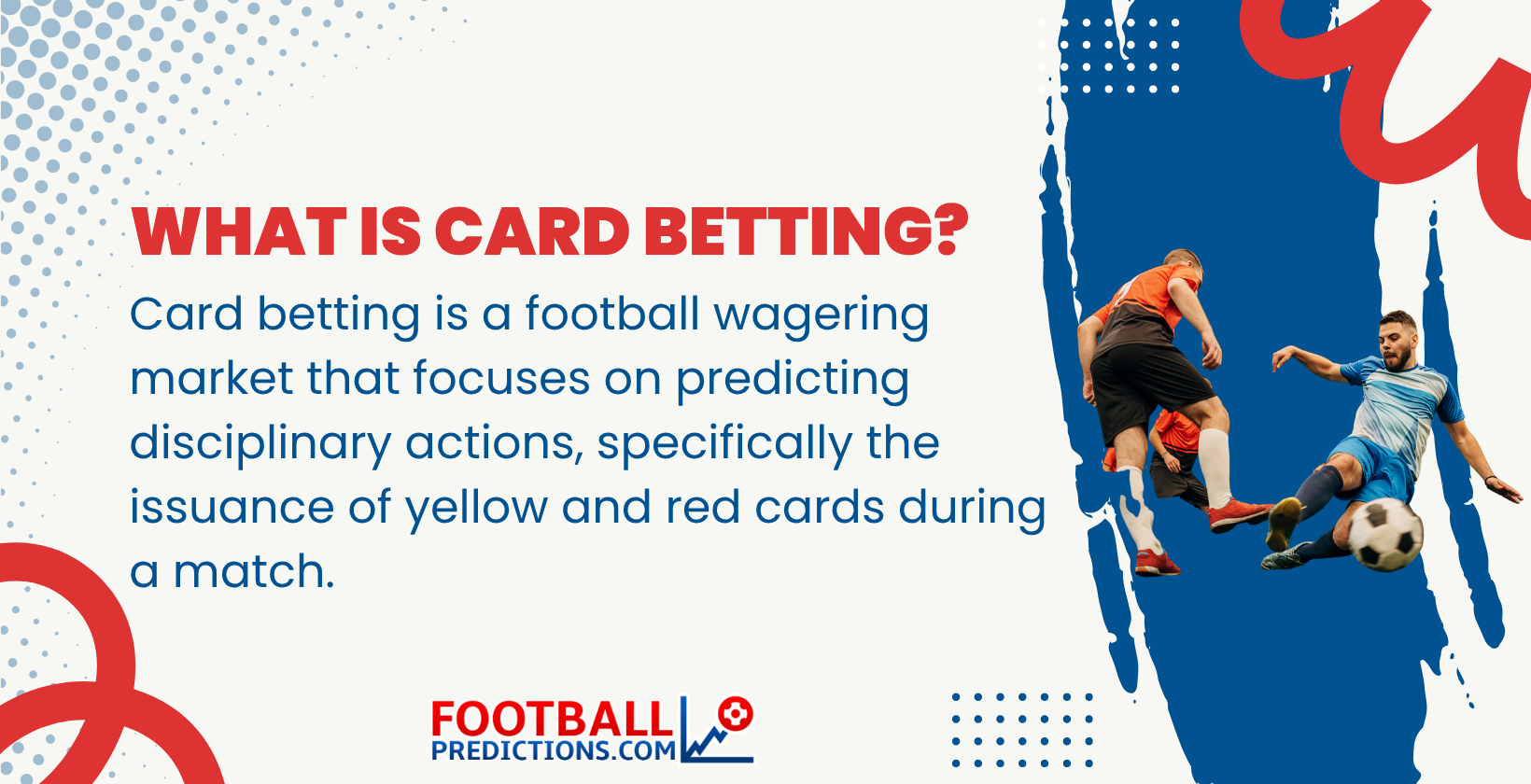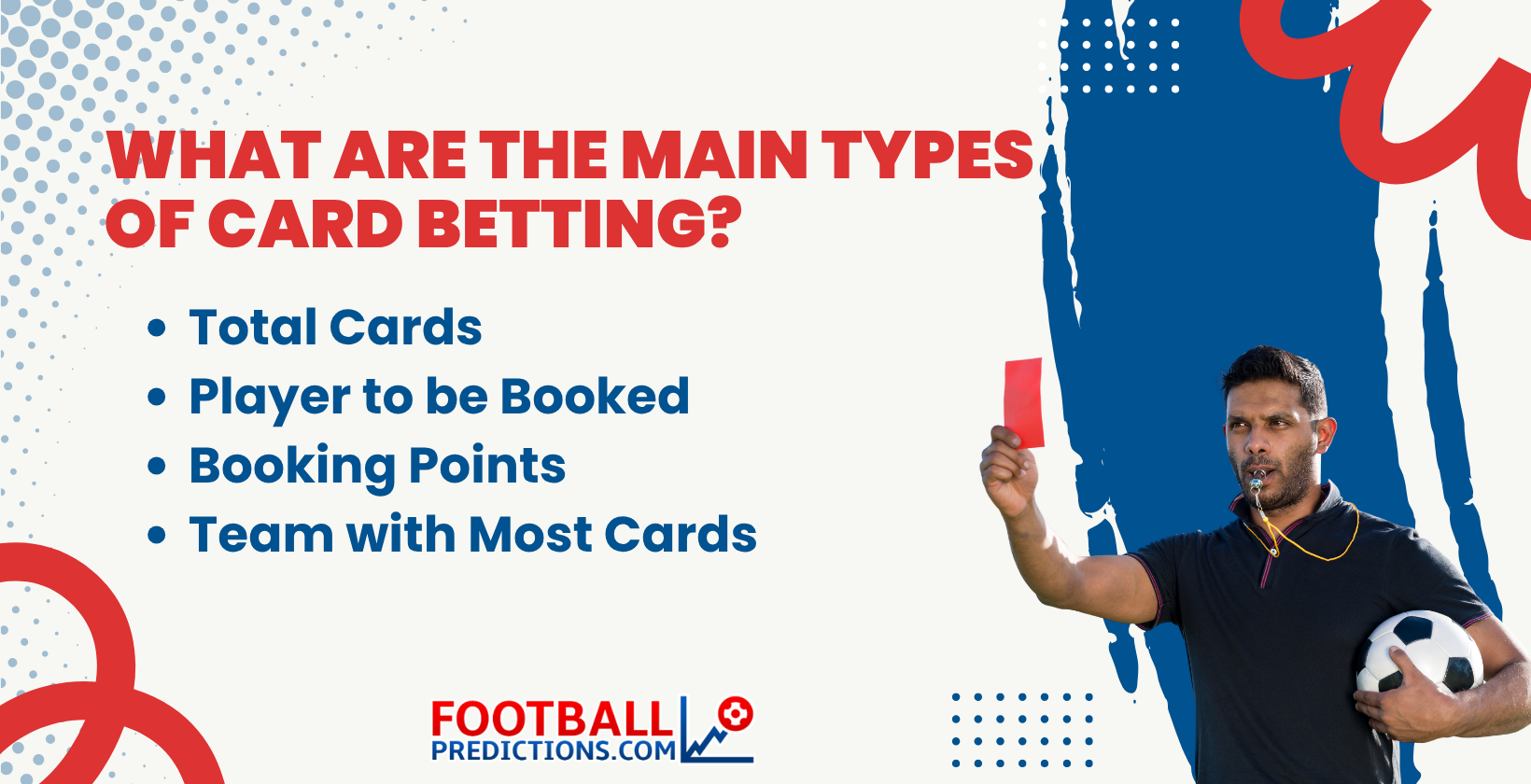Football Card Betting: Tips and Strategy

Card betting refers to wagering on yellow and red cards shown during football matches, rather than goals or final results. Card bets include a wide range of markets such as Total Cards, Player to Be Booked, Booking Points, and Team with Most Cards. These bets focus on discipline and match intensity, offering high-value odds for well-informed selections.
Card betting predictions are based on player discipline stats, team foul averages, referee profiles, and match context such as derbies or high-stakes games. These factors help identify which matches are more likely to produce bookings.
The steps to place a card bet include analysing disciplinary trends, choosing a reputable bookmaker, locating the card markets, and entering your stake. Bookmakers often host these markets in Bet Builder sections or under ‘Cards’ or ‘Discipline’ tabs.
The pros of card betting are the strong odds for niche outcomes and the advantage it gives to bettors who study stats and referee tendencies in depth. This market rewards research over guesswork. The drawbacks of card betting include limited availability for smaller fixtures and high unpredictability caused by inconsistent refereeing or match flow changes.
A successful card betting strategy is based on analysing card trends for teams and players, reviewing referee histories, and considering match intensity. These elements create a more accurate picture of potential booking outcomes.
The best leagues for card betting are Bolivia’s Liga de Fútbol Profesional, Colombia’s Categoría Primera A, Spain’s La Liga, and Italy’s Serie A, each known for frequent fouls, high disciplinary totals, and referees with low tolerance for aggressive play
Common combinations between card betting and other markets include Player to Be Carded & Match Result and Over X Cards & BTTS, both designed to increase returns through match-specific insights and strategic betting.
Table of Contents
Today’s Card Betting Tips
What is Card Betting?
Card betting is a football wagering market that focuses on predicting disciplinary actions, specifically the issuance of yellow and red cards during a match. Unlike traditional bets that concentrate on outcomes like the final score or number of goals, card betting allows punters to place bets on how many cards will be shown, which players or teams will receive them, and other related outcomes. This form of betting is especially popular in high-intensity matches where fouls and bookings are more likely.

Card betting includes several types of markets. The “Total Cards” market involves betting on whether the total number of cards in a match will be over or under a specific number. The “Player to Be Booked” market allows bets on individual players to receive a yellow or red card. Other popular options include “Team with Most Cards” and bets based on “Booking Points”, where yellow cards are typically worth 10 points and red cards 25 points. These bets require careful analysis of player discipline, team aggression, and referee statistics to make informed predictions.
What are the main types of card betting?
Card betting refers to placing wagers on disciplinary actions in football matches, specifically the issuing of yellow and red cards. However, there are several different ways to approach this market depending on the focus of the bet. The four main types of card betting are Total Cards, Player to Be Booked, Booking Points, and Team with Most Cards.
More information on the four main types of card betting is given below.
- Total Cards. Total Cards is a market where you bet on the number of cards shown in a match. This is often presented as an Over/Under bet, such as Over 4.5 Cards, meaning you win the bet if there are five or more cards issued during the match.
- Player to Be Booked. Player to Be Booked refers to betting on specific players to receive a yellow or red card. This market is influenced by the player’s role, playing style, and disciplinary history. Defenders and defensive midfielders are typically favoured choices in this category.
- Booking Points. Booking Points is a subtype of Total Cards betting where cards are assigned point values. A yellow card is usually worth 10 points and a red card 25 points. Bettors wager on total booking points or predict which team will accumulate more points. This version is common when bookmakers do not offer a standard “Total Cards” count.
- Team with Most Cards. Team with Most Cards is a market that involves predicting which team will receive more cards during the match. While most bookmakers offer the first three markets consistently, the “Team with Most Cards” option is not always available or appears under a different name, such as “Team with Most Booking Points.” Always check the terminology and availability on your chosen betting platform.

How to place a Card Betting bet?
Placing a card bet involves four key steps that help ensure your wager is well-informed and accurately placed. You need to analyse team and player discipline stats, select a trusted bookmaker with the right markets, navigate to the card market section, and place your stake.
The four main steps of placing a Card Betting bet are explained below.
- Analyse Team and Player Discipline Stats. Start by reviewing how often teams and players receive yellow and red cards. Some clubs regularly commit more fouls due to their playing style or tactical setup. Players in defensive roles such as centre-backs or holding midfielders are more likely to be booked. Check recent stats and consider the referee’s history with issuing cards, as some are known for being stricter than others.
- Select a Trusted Bookmaker. Pick a reputable bookmaker that offers a range of card betting markets. Sites like Bet365, Paddy Power, and William Hill usually include these markets, either in the main match menu or within Bet Builder tools. Make sure your chosen platform provides access to key markets like Player to Be Booked, Total Cards, and Booking Points.
- Navigate to the Card Markets. Once you’ve chosen a match, head to the card betting section. This market is often listed under headings such as “Cards,” “Discipline,” or “Booking Points.” Look through the available bets, which typically include totals, individual player bookings, or which team will receive more cards. Select the one that matches your prediction.
- Place Your Stake. Add your chosen selection to the bet slip and enter your stake. Double-check whether the market covers full-time only or includes extra time. Once you’re satisfied with your choices, confirm the bet. The wager will be tracked and settled based on the number and type of cards issued during the game.
What Are the Pros and Cons of Card Betting?
Card betting offers two major advantages. First, it provides high value for niche outcomes such as “player to be booked”. Second, card betting rewards bettors who conduct deep research on referees, player discipline, and match context. At the same time, there are notable drawbacks. The disadvantages of card betting include limited market availability and high unpredictability caused by refereeing styles and shifting match intensity.
More details on the two main pros of card betting are given below.
- High Value from Niche Outcome. Card betting offers strong value in markets that are often overlooked by casual punters, such as “Player to Be Booked” or “Team With Most Bookings.” These outcomes typically come with better odds than mainstream bets because they rely on specific match events rather than general results. When based on solid research, including player discipline records, team aggression levels, or referee tendencies, these bets allow informed bettors to find value where the public market is less focused.
- Rewards Deep Research. Success in card betting relies on detailed analysis. Bettors who study disciplinary records, player roles, team tactics, and referee behaviour gain a real advantage. For instance, knowing that a specific centre-back has five bookings in his last seven appearances, or that a certain referee averages 5.4 cards per game, adds precision to your predictions. Unlike more random goal markets, card betting gives a clear edge to those who follow trends and spot patterns.
Detailed information on the two main cons of card betting follows below.
- Limited Market Availability. Not all bookmakers offer a full suite of card betting markets, especially for smaller leagues or low-profile games. Some markets, like “Team with Most Cards” are often hidden within Bet Builder tools or only appear close to kick-off. This makes it harder to plan and place bets in advance. In some cases, bettors find that their preferred market is unavailable entirely, restricting their strategy options.
- Unpredictability Due to Referees and Game Flow. Card totals fluctuate widely depending on refereeing styles and how the match unfolds. Referees sometimes issue four bookings in the first half, then none in the second. Games expected to be aggressive sometimes turn passive due to early goals or tactical shifts. Even with strong data, last-minute changes such as a cautious referee or a lineup missing key agitators tend to derail what seemed like a solid bet. This level of uncertainty makes card betting more volatile than many other markets.
What are the Best Leagues and Teams for Card Betting?
When selecting leagues and teams for card betting, it’s crucial to focus on those with consistently high averages of yellow and red cards per match. Such leagues often feature aggressive play styles, intense rivalries, and referees who are more inclined to issue cards. By targeting these leagues, bettors are able to identify matches with a higher likelihood of bookings, enhancing the potential for successful card-related wagers.
Based on recent data, the four leagues that stand out for their high card frequencies are Bolivia’s Liga de Fútbol Profesional, Colombia’s Categoría Primera A, Spain’s La Liga, and Italy’s Serie A.
More information on the four best leagues for card betting is given below.
- Bolivia – Liga de Fútbol Profesional Boliviano. Bolivia’s professional football league leads globally with an average of nearly 8 cards per match. Approximately 98% of games conclude with over 4 cards, making it a prime choice for the card betting market.
- Colombia – Categoría Primera A. Known for its physical gameplay, Colombia’s A category league averages around 6.3 cards per match. The competitive nature and frequent fouls contribute to its high card count.
- Spain – La Liga. Among Europe’s top leagues, Spain’s La Liga exhibits the highest average of yellow cards per game. Teams like Getafe and Sevilla are particularly notable for their disciplinary records, often leading in bookings.
- Italy – Serie A. Consistently ranking high in card statistics, teams from Serie A like Hellas Verona and Empoli frequently top the charts for yellow and red cards. The league’s tactical fouls and intense matches contribute to its elevated card averages.
By focusing on these leagues, bettors are able to leverage the higher likelihood of bookings to inform their card betting strategies effectively.
How to implement a Card Betting strategy?
To implement a successful Card Betting strategy, focus on team and player card history, referee tendencies, and match context. These factors help identify high-risk fixtures where cards are more likely to be shown, improving your chances of making accurate predictions.
Firstly, analyse team and player card history. Look for teams with high averages of yellow and red cards per game and players with frequent bookings, especially defensive midfielders and aggressive defenders. Reliable sources like FootyStats and WhoScored offer up-to-date disciplinary records. Players with recent yellow cards or suspensions often indicate a persistent playing style that increases the likelihood of another booking.
Secondly, research the referee’s tendencies. Some referees consistently show more cards than others, regardless of the teams involved. Referee stats reveal averages for yellow and red cards per match. Referees with a low tolerance for fouls and dissent create a more card-friendly betting environment.
Thirdly, consider the match context. Derbies, relegation battles, and high-stakes fixtures typically involve more fouls and emotional intensity, leading to more bookings. Tactical styles matter too. Press-heavy teams and those that foul to disrupt play increase the chance of cards. Identifying these dynamics helps you anticipate how a match will unfold in terms of discipline.
What are Card Betting predictions based on?
Card Betting predictions are based on a combination of disciplinary statistics, referee profiles, and situational match dynamics that influence the likelihood of bookings.
The most important indicators include each team’s average cards per game and the history of individual players receiving yellow or red cards. For example, teams like Getafe and Lazio consistently rank among the highest for fouls committed and cards received, making their fixtures ideal for card-focused bets. In addition to team statistics, predicting card outcomes relies on knowing which players tend to get booked most often, such as defensive midfielders or full-backs tasked with stopping fast attackers.
Another crucial element is the referee assigned to the match. Some referees average over five cards per game, while others are more lenient. High-card referees significantly increase the likelihood of bets landing, especially when paired with aggressive teams.
Additional match context, like local derbies, relegation battles, or high-pressure knockout games further raises tension levels and leads to more fouls, making them prime targets for card betting predictions.
Should I combine Card Betting with other markets?
Yes, you should combine card betting with other markets such as BTTS to increase potential returns and add flexibility to your bet. These combos are ideal for bettors who follow team news closely and understand which matches are more likely to produce aggressive play, fouls, and disciplinary action.
Below are three of the most useful card betting combinations.
- Player to Be Carded & Match Result. This combination requires you to correctly predict both the outcome of the match and a specific player to receive a yellow or red card. It suits matches where a high-intensity rivalry or tactical matchup increases the likelihood of bookings and one team is expected to win. For example, a defensive midfielder prone to fouls combined with a win for a dominant home side.
- Over X Cards & BTTS. In games featuring attacking teams with poor discipline, combining Over 4.5 Total Cards with Both Teams to Score creates high-value odds. These fixtures often feature end-to-end action, open play, and frequent challenges, which are perfect conditions for both goals and bookings. The Both Teams to Score leg adds value when both sides have consistent scoring form, especially against leaky defences.
These combinations are typically placed using a bet builder or same-game multi, giving punters the chance to customise their wagers based on match-specific narratives. Although risk increases with more conditions, so does the potential payout.
What are card predictions based on?
Card betting predictions are based on key indicators such as average cards per match for each team, disciplinary records of specific players, and the historical behaviour of referees. Matches involving aggressive teams, defensive formations, or heated rivalries tend to produce higher card totals.
Analysts factor in the importance of the fixture, as derbies, relegation fights, or knockout rounds often trigger more fouls and disciplinary action. Player roles such as defensive midfielders or full-backs often involve high-risk defensive actions, increasing their chance of receiving cards. Referee data plays a major role as well, with some officials known for strict enforcement and frequent bookings. By aligning these elements with current team strategies and player availability, bettors generate informed card predictions based on evidence rather than guesswork.
When are Card Betting predictions updated?
Card betting predictions are typically updated throughout the week leading up to a match, with more refined updates posted in the final 24 to 48 hours before kick-off. These updates incorporate the latest information on team news, referee assignments, and tactical setups, all of which heavily influence card-related outcomes.
Early predictions focus on team discipline stats, average number of cards per game, and historical data from previous matchups. As kick-off approaches, analysts factor in referee profiles, which are especially important since some referees consistently show more cards than others. Tactical adjustments, such as starting more aggressive players or using a high press, trigger late changes in card predictions as well. By timing your research around these updates, you reduce the risk of outdated or inaccurate selections.
When to avoid Card Betting?
Avoid card betting when team lineups are uncertain, as this limits your ability to identify players most likely to receive cards. Aggressive defenders and combative midfielders are often the focus of card markets, and predictions based on past trends become unreliable if they are missing from the starting eleven.
Another situation to avoid card betting is when referee data is unavailable. The referee’s historical average of yellow and red cards, their approach to physical play, and their booking frequency all influence card outcomes. Without this information, assessing the match environment becomes speculative rather than strategic.
Lastly, avoid card betting in matches that lack intensity. Friendlies, group stage dead rubbers, or games with no rivalry or stakes usually feature fewer fouls and less physical confrontation. These conditions reduce the likelihood of cards being issued, weakening the potential of card-focused bets.
Is card betting suitable for all types of punters?
No, card betting is suitable specifically for punters who rely on detailed match data rather than simple score-based predictions. The cards market rewards those who analyse player discipline and referee profiles to anticipate bookings.
Players with a history of late tackles, dissent, and frequent fouling are more likely to be booked, especially in high-stakes or emotionally charged matches. Identifying these patterns gives card bettors an edge when selecting likely candidates for bookings or predicting overall card totals. Referees play a key role as well. Some have a consistent pattern of issuing more yellow and red cards than others. Punters who analyse both player discipline and referee tendencies, supported by structured football betting tips are more likely to make accurate predictions within the cards market.










